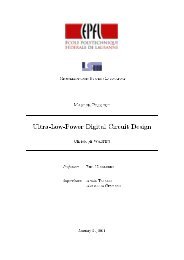Compressive Sensing system for recording of ECoG signals in-vivo
Compressive Sensing system for recording of ECoG signals in-vivo
Compressive Sensing system for recording of ECoG signals in-vivo
Create successful ePaper yourself
Turn your PDF publications into a flip-book with our unique Google optimized e-Paper software.
considered switch is almost ideal, that is, the close circuit resistance is 1 Ω and the open circuitresistance is 1 TΩ. The control voltages have been chosen as under<strong>for</strong> clos<strong>in</strong>gthe switch, and overto close it. In this way the uncerta<strong>in</strong> range <strong>of</strong> control voltageis m<strong>in</strong>imize, but anyway the random b<strong>in</strong>ary sequence does not distort. The mixer-<strong>in</strong>tegrator hasbeen sketched <strong>in</strong> Fig.6.2.1.1. A complete multipath acquisition array has been implemented <strong>in</strong>Cadence by consider<strong>in</strong>g N = 128 and M = 64. The result<strong>in</strong>g compressed signal has beencompared <strong>in</strong> Fig.6.2.1.3 with the one which has resulted <strong>in</strong> Matlab implementation.As the reconstructed signal is robust <strong>in</strong> both <strong>of</strong> the models, the differences regard<strong>in</strong>g thesamples <strong>of</strong> the compressed signal have to be caused by non-idealities dur<strong>in</strong>g the sampl<strong>in</strong>g and<strong>in</strong>tegrat<strong>in</strong>g phases. The compressed signal com<strong>in</strong>g from Cadence is slightly different to the onewhich has been calculated <strong>in</strong> Matlab, so the reconstruction signal <strong>for</strong> both <strong>of</strong> the models iscompared <strong>in</strong> Fig.6.2.1.4 <strong>for</strong> LASSO reconstruction method and <strong>in</strong> Fig.6.2.1.5 <strong>for</strong> BPDM. InLASSO-based reconstruction (see Eq.15) and <strong>in</strong> BPDN-based reconstruction(see Eq.14). Both <strong>of</strong> the values have been chosen as those which have led a better SNRbetween the orig<strong>in</strong>al signal and the reconstructed one. Hereafter reconstructed <strong>signals</strong> are<strong>in</strong>cluded <strong>for</strong> each topology, a comparison between all <strong>of</strong> them is <strong>in</strong>troduced at 6.2.5 and SNRcomparison is <strong>in</strong>cluded <strong>in</strong> 6.2.6.Figure 6.2.1.3. Compressed <strong>signals</strong> comparison.It is clear that this topology cannot be used <strong>for</strong> CS purposes on-chip, because <strong>in</strong> order to<strong>in</strong>crease the signal sw<strong>in</strong>g it is necessary to <strong>in</strong>crease the RC ratio, and so, it becomes a noimplementable design due to area constra<strong>in</strong>ts.57















